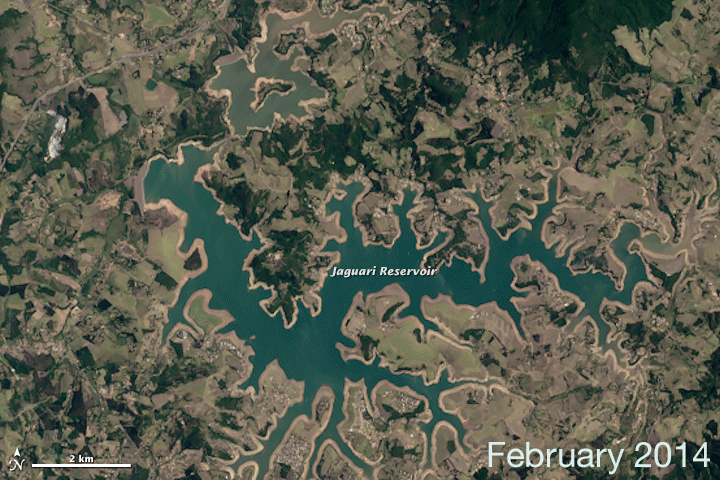News•March 10, 2015
Sao Paulo’s Reservoirs Feel Pinch of Failed Wet Season

By Brian Kahn
Sao Paulo, in the wake of another dry summer in southeast Brazil, continues to struggle with a multi-year drought. The city has implemented water rationing, but reservoir levels still hover at perilously low levels and will likely remain there or drop even further as the usual rainy season ends.
What is traditionally the rainy season runs from September through April and brings the most rain from December through February. Yet for the second year in a row, rains have failed to fully materialize. The 2013-14 wet season saw rainfall deficits of nearly 16 inches and this year, though not quite as bad as last, is running up to 8 inches below normal according to data available from the International Research Institute for Climate and Society.
Credit: NASA Earth Observatory
A wet burst at the end of February provided some relief, but Sao Paulo’s Cantareira Reservoir System, which provides nearly half the drinking water for Sao Paulo’s 20 million residents, is still in rough shape. Its five reservoirs are only about 13 percent full and as of Tuesday, the Jaguari Reservoir, which sits at the top, was just 8.72 percent full.
That led officials to require water restrictions, cutting off water for days at a time, and pushed Sao Paulo residents to start drilling illegal wells in the city in search of water. According to NPR, economists estimate that the drought could cost Sao Paulo 2 percent of its GDP.
Landsat 8 images published by the NASA Earth Observatory show the dismal state of the Jaguari Reservoir this February compared to last year when drought first started to exact a heavy toll. A wet February helped green the landscape, but it’s just window dressing. The mud flats, shrinking water footprint and newly formed islands in the Jaguari Reservoir tell the full story of a failed rainy season.
Satellite imagery of the Jaguari Reservoir in February 2014, October 2014 and February 2015.
Credit: NASA Earth Observatory

Recent research has shown that the southeast Amazon has dried by 25 percent since 2000. Signs point to deforestation and changes in atmospheric circulation as possible drivers.
According to The Economist, five of the 10 driest years for the Cantareira System have come since 2000, including last year’s record-low year. Even with the recent bump in rain, this could be the driest back-to-back series of wet seasons in at least 35 years. Some models project the region could continue getting drier as a result of climate change.
Dry conditions are not the only factor in Sao Paulo’s disappearing drinking water. Leaks across the system, a booming population and deforestation have all had a role in dropping Sao Paulo’s reservoirs into their precarious situation today. But the risk of future drying could create bigger problems for a metro area likely to reach 23.4 million residents by 2030.
You May Also Like:
Cleaner Power Needed to Make Electric Cars Greener
Warming Could Hit Rates Unseen in 1,000 Years
Drought Weakens the Amazon’s Ability to Capture Carbon
Maps Show El Niño Won’t Help the West’s Water Woes
